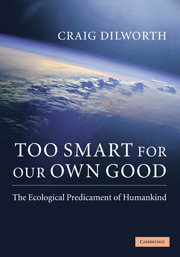Book contents
- Frontmatter
- Contents
- List of figures and tables
- Preface
- Introduction
- 1 Scientific ground rules
- 2 The new views in anthropology, archaeology and economics
- 3 Theoretical background to the vicious circle principle
- 4 The vicious circle principle of the development of humankind
- 5 The development of humankind
- 6 The vicious circle today
- 7 … and too dumb to change
- Conclusion
- Glossary
- Notes
- References
- Index
3 - Theoretical background to the vicious circle principle
Published online by Cambridge University Press: 25 January 2011
- Frontmatter
- Contents
- List of figures and tables
- Preface
- Introduction
- 1 Scientific ground rules
- 2 The new views in anthropology, archaeology and economics
- 3 Theoretical background to the vicious circle principle
- 4 The vicious circle principle of the development of humankind
- 5 The development of humankind
- 6 The vicious circle today
- 7 … and too dumb to change
- Conclusion
- Glossary
- Notes
- References
- Index
Summary
The principle of population
The principle of population was put forward by Thomas Malthus in 1798. In the first edition of his Essay on the Principle of Population he characterises it as “The perpetual tendency in the race of man to increase beyond the means of subsistence,” which he considers to be “one of the general laws of animated nature which we have no reason to expect will change.”
Though in discussions regarding the principle it has only been taken in its application to humans, as suggested by Malthus in the above quote, as well as more explicitly in his Summary View of the Principle of Population published in 1830, it is clear that it should apply to any animal or plant species, in keeping with the energy-gathering (counter-entropic) nature of the populations of all organisms.
Thus the principle of population is a biological principle, and may in fact be seen as a corollary to the principle of evolution. It clearly had a profound influence on Darwin:
In October 1838, that is, fifteen months after I had begun my systematic enquiry, I happened to read for amusement Malthus on Population, and being well prepared to appreciate the struggle for existence which everywhere goes on from long-continued observation of the habits of animals and plants, it at once struck me that under these circumstances favourable variations would tend to be preserved and unfavourable ones to be destroyed. The result of this would be the formation of new species. Here, then, I had at last got a theory by which to work.[…]
- Type
- Chapter
- Information
- Too Smart for our Own GoodThe Ecological Predicament of Humankind, pp. 99 - 108Publisher: Cambridge University PressPrint publication year: 2009

